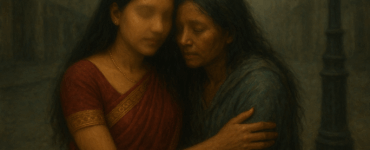 In 2020 I came across a platform on Facebook called Le thinnai kreyol. That was my first introduction to the Tamil word “thinnai”. This platform run by academic Ananya Jahanara Kabir and author Ari Gautier took me on a wonderful journey of discovering creolisation in ways known, little known and unknown. In the midst of the lockdown, working from home, this social media platform took me out into another world, into fascinating journeys that involved history, place, people, food, dress, literature, music and dance. The word “thinnai” refers to that part of the home that one encounters the moment one enters into a traditional home in Tamil Nadu and other parts of South India. It is a partly covered space, usually with wooden pillars, a social space outside but an important part of the house. The word “thinnai” took me back to a past that had associations with that space. I remember Amma’s Tatagaru in his dhoti, sitting on that huge wooden chair, a cheroot in his hand, meeting the local villagers and talking. That space, the ‘vakili’ in Telugu, was also one were I remember dancing to a rabindra sangeet that I belted out in response to Tatagaru’s wishes with my cousins watching me on one of my summer visits to Amma’s grandparents’ place in Nayakampalli village in Andhra Pradesh.
In 2020 I came across a platform on Facebook called Le thinnai kreyol. That was my first introduction to the Tamil word “thinnai”. This platform run by academic Ananya Jahanara Kabir and author Ari Gautier took me on a wonderful journey of discovering creolisation in ways known, little known and unknown. In the midst of the lockdown, working from home, this social media platform took me out into another world, into fascinating journeys that involved history, place, people, food, dress, literature, music and dance. The word “thinnai” refers to that part of the home that one encounters the moment one enters into a traditional home in Tamil Nadu and other parts of South India. It is a partly covered space, usually with wooden pillars, a social space outside but an important part of the house. The word “thinnai” took me back to a past that had associations with that space. I remember Amma’s Tatagaru in his dhoti, sitting on that huge wooden chair, a cheroot in his hand, meeting the local villagers and talking. That space, the ‘vakili’ in Telugu, was also one were I remember dancing to a rabindra sangeet that I belted out in response to Tatagaru’s wishes with my cousins watching me on one of my summer visits to Amma’s grandparents’ place in Nayakampalli village in Andhra Pradesh.
Le Thinnai is the name of the French novel written by Ari Gautier. Gautier was born in Madagascar, traces his roots to Pondicherry, lived for a some time in India and France and is now based in Oslo, Norway. Available in English translation done by Blake Smith, The Thinnai is a novel that is part of my Durga Pujo reading. Set in a working class neighbourhood of Kuruskuppam in Pondicherry The Thinnai speaks of the arrival of a Frenchman to the narrator’s ‘thinnai’ on 14th July. This Frenchman, Gilbert Thatha, then begins to recount stories of the troubles that befell his family in the 1700s, at a time when the French colonized India. He has a small boy along with him, Little Gilbert, whom he claims to have rescued.
This is how Gautier speaks of the origin of the name of the place Kurusukuppam in the novel–
No one knew our neighbourhood’s real name. It had started as a shelter for fishermen. Some said that the name Kurichikuppam came from kurichi, a flat, silvery fish about 20 centimetres long. There was an abundance of these fish in the kuppam – a village of fishermen or low-caste people. But others insist that Kuruskuppam owed its name to the cross, or kurusu, atop the church.
The thinnai, the place where stories were told and recounted, is the place where the narrator’s father sat and spoke about his ancestors and their business with faraway lands and is described as “the soul of the house”. The neighbourhood of Kurusukuppam and its people and streets, the house, the French soldiers, the Tamil activists, the creoles, communists, the locals, and these two characters who arrive, are all described in vivid details. Kurusukuppam, we are told, is a working class neighbourhood that is far removed from the Pondicherry that one usually associates it with (Pondicherry usually conjures up images of a tourist place that has a French legacy and its associations with Sri Aurobindo).
Kurusukuppam’s inhabitants had a mania for giving nick-names: Three-Balls Six-Faces, Edouard the Cripple, Joseph One-and-a Half Eye, Emile Kozhukattai-head, Jean-Claude Cow Shit, broken-Arm Perumal, Good Bald Jean.
Gilbert Thatha’s story of his family goes back to a much earlier period, a family who were “stuck with Sita’s curse”. He claims that his family were the custodians of the diamond, a mysterious stone that he refers to as the Stone of Sita. As he begins to recount his family’s narrative, we encounter a story that moves across time and place. The story that he recounts goes back to the 17th century, it begins with his ancestors who came from the north of France, from a village near Douai. One of them undertook a journey that takes him across lands in a series of adventures fraught with difficulties and calamities and finally decided to stay in India till he got rich. It was then that he heard of the mysterious stone. As Gilbert Thatha recounts the story his listeners are held in thrall.
Weaving in place, people and history, The Thinnai is a novel that takes one on a journey that reveals the way life has been shaped in Pondicherry, of the small little facets of the past that are so much a part of the present day world of the place. With characters that are eccentric, funny, simple and interesting the novel takes us into the world of Francophone Indian fiction.
*









Add comment